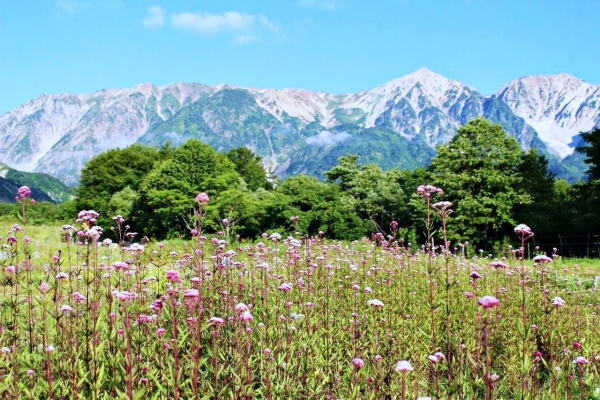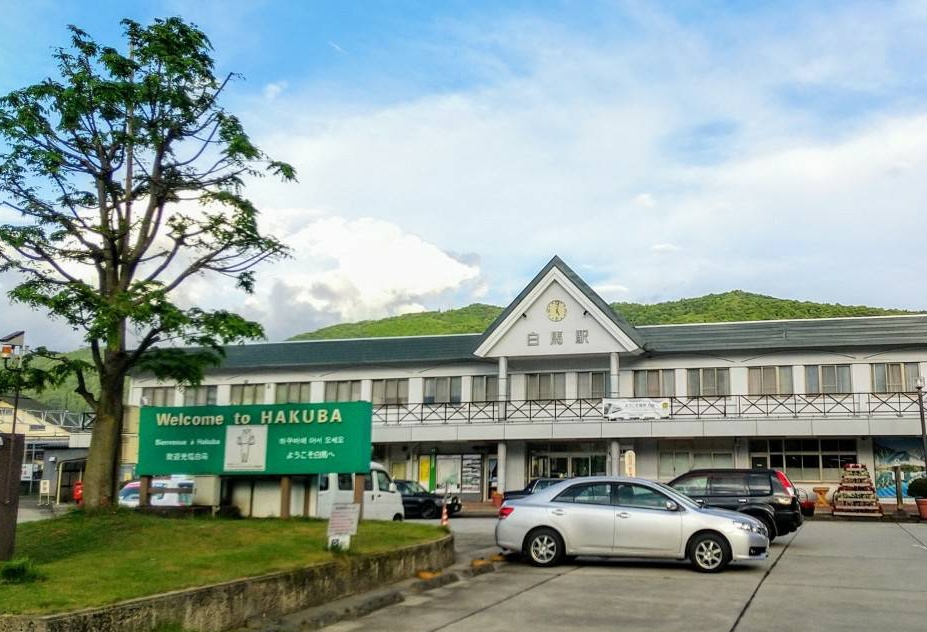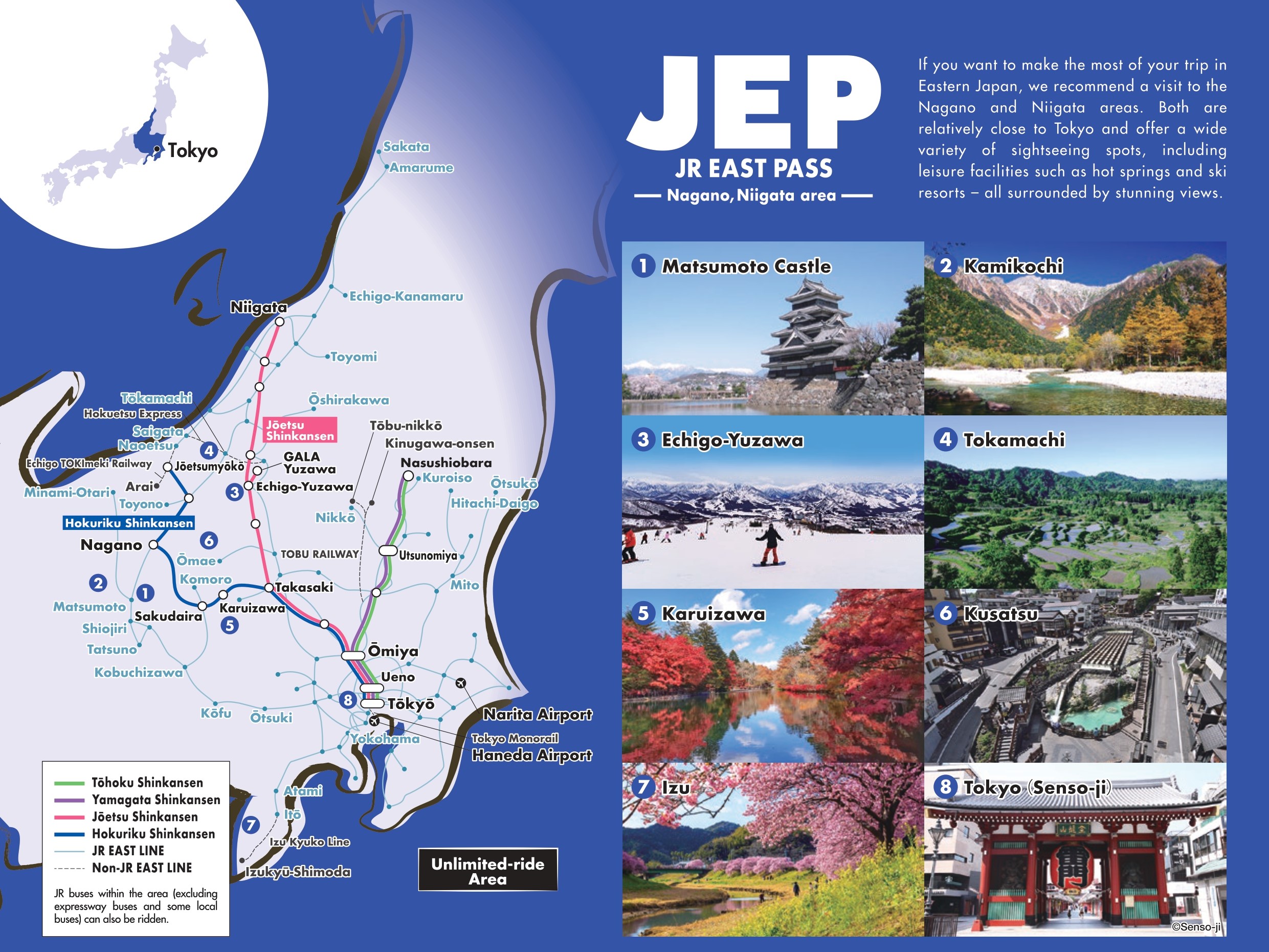Hakuba in summer Part 2: Amazing adventures await!

Located at the foot of an impressive mountain range, the village of Hakuba (白馬) in Nagano Prefecture (長野県) offers mesmerising views of alpine scenery from all over the village. The numerous gondolas and lifts around Hakuba bring you closer to Nature, and let you experience even more expansive views from higher altitudes. However, other than gondolas and lifts, cycling and hiking are also great ways to explore this charming area during summer, when the majestic mountains come to life.
In Part 2 of our two-part series on a 3D2N summer trip around Hakuba, let us introduce you to some of the scenic spots we visited, along with some of our top recommendations!
Day 2: A scenic bicycle ride around Hakuba

Oide Suspension Bridge and view of Oide Park. (Image credit: JR East / Carissa Loh)
In the previous article, we left off having lunch at Kappatei, a quaint café across the suspension bridge from Oide Park. Just look at that view! Scenery like this is one of the reasons why we feel that summer is the best season to enjoy Hakuba. After a delicious lunch of Shinshu salmon, we hopped back on our e-bikes and continued cycling towards our next stop, Matsukawa Bridge, for a view of the Matsu River.
Cooling off in the Matsu River (松川)

View of the Matsu River from Hakuba Bridge. (Image credit: JR East / Akio Kobori)
Flowing directly from the Hakuba Daisekkei Snow Gorge (白馬大雪渓 Hakuba Daisekkei), the brilliant blue Matsu River (松川 Matsukawa) offers fantastic scenery and cool waters to beat the summer heat. For taking the best photos of the Matsu River, we recommend going to either Matsukawa Bridge (松川大橋 Matsukawa О̄hashi) or Hakuba Bridge (白馬大橋 Hakuba О̄hashi).

Enroute from Matsukawa Bridge to Hakuba Bridge. (Image credit: JR East / Akinori Ueno)
Tip: cycle alongside the river when travelling between the two bridges. The view was fantastic, and the feeling of cool air flowing past our faces as we cycled was very refreshing. The path was on a slight incline, but the e-bikes made it so much easier to pedal up!
As we cycled, the magnificent peaks of Hakuba Sanzan beckoned us. It was amazing how the three peaks of Shirouma-dake (2,932m), Shakushi-dake (2,812m) and Hakuba Yarigatake (2,903m)—known collectively as Hakuba Sanzan (白馬三山 the three mountains of Hakuba)—appeared so close to us. Even though it was already summer, there was still a little bit of snow remaining on their peaks.
A cooling dip in the Matsu River. (Image credit: JR East / Akio Kobori)
Other than enjoying the picture-perfect view of the river with the mighty mountains in the background, why not also take a dip in the cool, clear waters to refresh yourself on a hot summer’s day? Visit Matsukawa Kasen Park (松川河川公園 Matsukawa Kasen Kо̄en) to take a cooling dip in the river. The park is right next to Hakuba Bridge. Although we were getting tired after half a day of eating and cycling, we instantly felt reenergized after frolicking in the Matsu River's cool waters.
Sandankoyo at Hakuba. (Image credit: JR East / Akio Kobori)
Our trip to Hakuba was in summer, but we definitely want to come back again in autumn to catch the sandankoyo. In autumn, there is a beautiful phenomenon known as sandankо̄yо̄ (三段紅葉 three layers of autumn colours). It usually starts snowing much earlier at the top of high mountains, but the nearby lower mountains are still developing autumn colours, while the ground level is still green. When this happens, you can see three layers of colours: white, orange, and green.
Hakuba Ski Jumping Stadium (白馬ジャンプ台)

Cycling towards the Hakuba Ski Jumping Stadium. (Image credit: JR East / Akinori Ueno)
After cooling off in the Matsu River, we headed to the Hakuba Ski Jumping Stadium (白馬ジャンプ台 Hakuba Janpu-dai). It was no sweat cycling along the inclined route from Hakuba Bridge to the stadium due to our trusty rented e-bikes! The route was filled with lush greenery, and we could enjoy Hakuba’s soaring mountains in front of us as we cycled on.
Soon, we could see the stadium in the distance. The Hakuba Ski Jumping Stadium was used in the 1998 Nagano Winter Olympics, and features two jumping hills at 90m and 120m.
Hakuba Ski Jumping Stadium. (Image credit: JR East / Carissa Loh (left) and Akio Kobori (right))
For a small fee, you can even go to the top of the ski jumping hills by chairlift and elevator. It is so high, and definitely not for anyone afraid of heights. From the top, you can experience what the athletes see as they prepare to jump down. Looking at the height of the hills, we wondered, how do the athletes do it? Do they have nerves of steel?
Relaxing at the footbaths
One of the rejuvenating footbaths around Hakuba. (Image Credit: JR East / Yuya Kumazaki)
Finally, after a long day of exploring, we took a break at the one of the many footbaths (足湯 ashiyu) around Hakuba to heal our fatigue. There are many of these footbaths dotted all over the village, and most are free to use. Some even provide good views of the surrounding mountains.

Map of our cycling route. Adapted from the Hakuba Cycle Map published by Tourism Commission of Hakuba Village.
Above is a map for our cycling route for the day. We started off and ended at the Happo Information Center (八方インフォメーションセンター Happо̄ Infomēshon Sentā), which was where we rented our e-bikes from. These bicycles have small motors to assist in the pedalling, which made it so much easier to go up the slopes.
Route:
Happo Information Center → ①koubo-nikki (bakery) → ②satoru coffee → ③Pochi no Takoyaki → ④Oide Park / Oide Suspension Bridge → ⑤Kappatei (lunch) → ⑥Matsukawa Bridge → ⑦Hakuba Bridge / Matsukawa Kasen Park → ⑧Hakuba Ski Jumping Stadium → Happo Information Center
Cosying up in a log cabin
Reposer’s cosy log-cabin style lodging. (Image credit: JR East / Carissa Loh)
For the second night, we wanted to try something different, so we opted to stay at Reposer, a quaint log-cabin style accommodation. The hotel is constructed mostly out of wood, and even has a real fireplace that is lit up in winter to keep guests warm! The cosy wooden interior was so comfortable, and made us feel closer to nature. With only six guest rooms, the service was very intimate, and staying here was truly the epitome of cosy.
Delicious dinner. (Image credit: JR East / Carissa Loh)
Like many other accommodations in Hakuba, Reposer serves up an Italian-style course dinner. Our very delicious and filling dinner had assorted appetisers, minestrone soup, a beef main dish, and apple tart with vanilla ice cream for dessert. Meals were meticulously prepared by an in-house chef, who would sometimes mingled with the guests in between courses. Reposer's restaurant also serves a la carte dinner for non-staying guests, and is a favourite amongst frequent visitors to Hakuba.

View of morgenrot on the Northern Alps from the hotel. (Image credit: JR East / Akinori Ueno)
Being tired from a day of cycling, we slept like logs that night. But our fatigue didn't stop up from waking up early to catch the sunrise. With clear skies that morning, we were lucky enough to witness a magical phenomenon known as morgenrot (モルゲンロート morugenrо̄ to). Derived from the German words for “morning” (morgen) and “red” (rot), morgenrot happens when the rising sun casts a reddish tinge on the peaks of the mountains. It is exceptionally beautiful when there is snow on the peaks (to better show off the red tinge), but is still an amazing sight to behold in summer.
 Morning views of the Northern Alps. (Image credit: JR East / Akinori Ueno)
Morning views of the Northern Alps. (Image credit: JR East / Akinori Ueno)
All of the hotel's six guest rooms overlook the mountains, and you can get a view of the Northern Alps, including Hakuba Sanzan, right from your bed. The morning air was so clear and fresh, so we spent some time just walking around the hotel—to gaze at the majesty of the mountains and enjoy the peacefulness. It is always a wonderful feeling to wake up to crisp mountain air and magnificent alpine scenery. Hakuba's proximity to the mountains never ceases to amaze us!
Day 3: Kitaone Highland (北尾根高原)
Enjoying Kitaone Highland in summer. (Image credit: JR East / Akio Kobori)
After a sumptuous Western breakfast, we took the Kitaone Quad Lift to Kitaone Highland (北尾根高原 Kitaone-Kо̄gen). At an altitude of 1,200m, Kitaone Highland has a terrace which offers fantastic views of the surrounding peaks and of the valley below.

Spectacular sunrise from Kitaone Highland. (Image credit: 八方尾根開発(株))
If you come on a weekend, we highly recommend visiting Kitaone Highland during sunrise for the phenomenal views! We came on a weekday so we were unable to check it out, but during summer and autumn weekends, there are sunrise tours—called the Morgenrot Goraiko Tour (モルゲンロートご来光ツアー)—to see the goraikо̄ (ご来光 sunrise from the mountain).

Magical morgenrot from Kitaone Highland. (Image credit: 八方尾根開発(株))
If the weather conditions are right, you can also view morgenrot from Kitaone Highland. The morgenrot views are made even more beautiful when the image is reflected in the still pond. Sunrise here is usually around 4:30–5:00, and the Kitaone Quad Lift will operate to fit the tour timings.
Morgenrot Goraiko Tour at Kitaone Higland. (Video credit: Hakuba Happo-one)
Reservations are required to join the tour, which must be made by 16:00 the day before. The tour costs ¥3,000 per person, and includes the round-trip gondola ride, breakfast, and pick-up and drop-off at the Happo Information Center. If the tour needs to be cancelled due to impending bad weather, you will be contacted by 15:00 the day before the tour. Check out the website here for more information (Japanese only).
Enjoy nature at Kitaone Highland. (Image credit: 八方尾根開発(株))
Due to the elevation, temperatures at Kitaone Highland are cooler compared to the village below. Here, we enjoyed fun activities like picnicking, lounging in the hammocks and viewing platforms, and hiking—there is a variety of trails to suit all fitness levels. There was even an alkaline footbath facing the mountain peaks, which was so relaxing and provided a wonderful view of the panoramic alpine scenery.
Hiking to Happo Pond (八方池) and beyond
The picturesque Happo Pond. (Image credit: Tourism Commission of Hakuba Village / JNTO)
If you’re slightly more adventurous, how about a hike to Happo Pond (八方池 Happо̄-ike)? The picturesque pond is especially breathtaking when the waters are still and the majestic mountains are perfectly reflected in them.
From Kitaone Highland, there is a free shuttle bus to the Kurobishi Lift. After taking the Kurobishi #3 Paired Lift to Kurobishi-daira, transfer to the Grat Quad Lift. Happo Pond is a 90-minute walk from the top of the Grat Quad Lift.
Alternatively, you can also access Happo Pond via the Happo Gondola Lift Adam → Alpen Quad Lift → Grat Quad Lift route if you are not going via Kitaone Highland.
Hiking around Happo Pond. (Image credit: JR East / Carissa Loh)
Mountain weather is always changing, so be prepared for both rain and shine. Happo Pond is 2,060m above sea level, so on some days, you can even see a sea of clouds (雲海 unkai) up close. Although the hike to Happo Pond involves climbing up some rocky terrain, it is still doable for anyone of reasonable fitness. (I saw many seniors during my visit!)

Looking up at the summit of Mount Karamatsu. (Image credit: JR East / Akio Kobori)
If you enjoy hiking and climbing, you can continue climbing from Happo Pond to the peak of Mount Karamatsu (唐松岳 Karamatsu-dake). This 3-hour climb is definitely not for casual tourists, as you will need proper climbing shoes and wet weather gear to reach the 2,696m peak.

The view from the top of Mount Karamatsu. (Image credit: JR East / Akio Kobori)
Standing at the top of a high mountain always makes me feel reflective, that all of my troubles seem so tiny compared to the vastness of the world. Although the climb to Mount Karamatsu can be done as a day trip if you start early, you can also stay overnight at the mountain hut on top to catch the goraiko the following morning. Watching the sun rise above the clouds is such a captivating sight. If the weather is clear, the sight of a beautiful goraiko will surely be deeply etched into your memory.
The mountain hut at Mount Karamatsu is also open to daytrip visitors, and you can stop by to take a rest or grab a bite to eat. Sipping on a cold drink after a long hike up is such a refreshing feeling, and is like a reward after an arduous day of climbing.
Access to Hakuba
 Exterior of JR Hakuba Station. (Image credit: JR East / Akinori Ueno)
Exterior of JR Hakuba Station. (Image credit: JR East / Akinori Ueno)
With so much beautiful scenery and a variety of fun experiences, Hakuba is a breathtaking village that is quickly becoming one of our favourites. Don't just associate it with winter; we highly recommend a visit in summer for anyone who loves nature and the outdoors. Hakuba is easily accessible by both train and bus from Tokyo and various cities around Nagano:
From JR Shinjuku Station (新宿駅):
- Train: 3 hours 40 minutes by direct Limited Express Azusa
- Bus: 5 hours
From JR Matsumoto Station (松本駅):
- Train: 1 hour by Limited Express Azusa
- Train: 2 hours by Resort View Furusato or local lines
From JR Nagano Station (長野駅):
- Train: approximately 3 hours by local lines
- Bus: 1 hour
Resort View Furusato
The Resort View Furusato against a backdrop of the Northern Alps. (Image credit: JR East)
If you are travelling to Hakuba from Nagano or Matsumoto on a weekend, check out the Resort View Furusato, a Joyful Train which offers panoramic vistas of Japan’s Northern Alps as it runs along the Oito Line parallel to these mountains. From the train’s wide windows, take in the view of the soaring peaks, many of which are close to 3,000m high.
Activities offered on a ride with the Resort View Furusato. (Image credit: JR East / Carissa Loh)
The highlight of this train is the myriad of fun activities at the various station along the ride. Enjoy a bird’s eye view of the Zenkoji Plains at Obasute Station (姨捨駅), explore Hotaka Shrine with a shrine maiden at Hotaka Station (穂高駅), tuck into some local snacks and drinks at Shinano-Omachi Station (信濃大町駅), and more.
From Nagano Station, the Resort View Furusato will pass by Matsumoto Station before reaching Hakuba Station. For a more detailed write-up on this train, check out this article. For more information, check the train’s website here. A one-way train ticket for the Resort View Furusato costs ¥1,700 for Matsumoto to Hakuba, and ¥2,840 for Nagano to Hakuba. However, rides are free if you are utilising a rail pass like the JR EAST PASS (Nagano, Niigata area).
JR EAST PASS (Nagano, Niigata area)

The new JR EAST PASS (Nagano, Niigata area) and usage area. (Image credit: JR East)
If you are thinking of visiting Hakuba or exploring the rest of Nagano Prefecture, check out the JR EAST PASS (Nagano, Niigata area), an affordable pass offering unlimited rail travel on JR East lines (including bullet trains and Joyful Trains like the Resort View Furusato) in the valid area for 5 consecutive days. At only ¥27,000, it makes for a great companion for rail travel around Nagano and Niigata. You can also make seat reservations for bullet trains, some limited express trains and Joyful Trains online for free, up to 1 month in advance, on the JR-EAST Train Reservation.

The JR-EAST Train Reservation. (Image credit: JR East)
Header image credit: 八方尾根開発(株)




